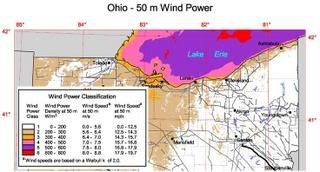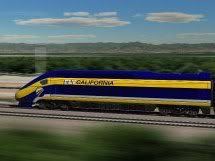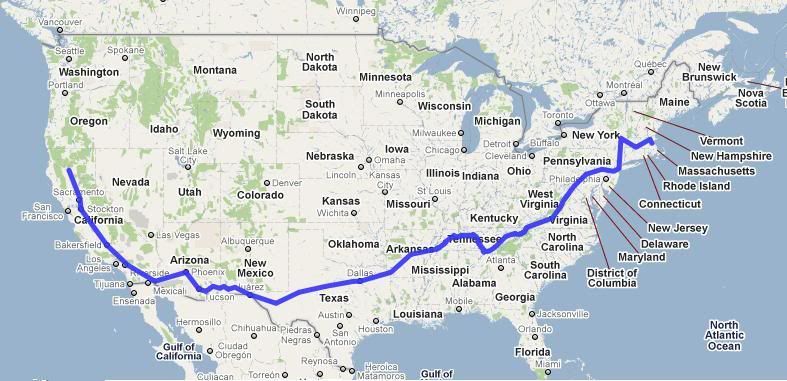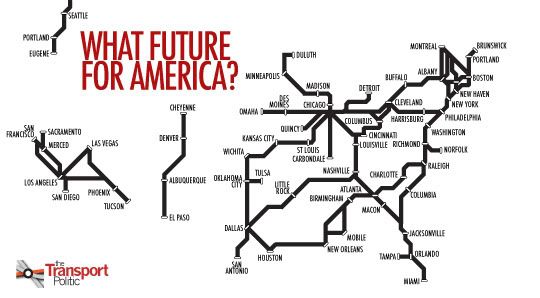Burning the Midnight Oil for Living Energy Independence
Note: a reprint of a Daily Kos diary from Jan, 2007
There is a common trend in my part of the Great Lakes States (Ohio, Indiana, Michigan) for discussion of sustainable energy to focus on commercial exploitation of the Wind Resource of the Great Lakes.
 And why the Great Lakes? Because that’s where the wind blows, as shown on the trimmed down version of the 2004 50m wind speed map for Ohio to the right. The pink, purple and red are the highest quality wind resources. (jpg) And this is just 50 metres … at 100 metres it gets better still.
And why the Great Lakes? Because that’s where the wind blows, as shown on the trimmed down version of the 2004 50m wind speed map for Ohio to the right. The pink, purple and red are the highest quality wind resources. (jpg) And this is just 50 metres … at 100 metres it gets better still.
So what does this have to do with driving? Well, sometimes the wind blows harder, and sometimes the wind blows softer … and on this point wind power and driving snuggle right together with a whole bunch of Energy Independence posts I have already made. How things link together … is after the fold.

 As I mentioned in last week’s Sunday Train, the California HSR Authority came out with a revised draft Business Plan.
As I mentioned in last week’s Sunday Train, the California HSR Authority came out with a revised draft Business Plan. The headlines out of California indicate that there has been a substantial shift in terms of the California HSR system. In particular, it seems that Gov. Brown has waded into the fray and is reframing the issue from the Only-An-Infrastructure-Geek-Could-Love frame of the Initial Construction Segment and the mythical “Train to Nowhere”, to the “when do I get to ride it?” frame of the Initial Operating Service.
The headlines out of California indicate that there has been a substantial shift in terms of the California HSR system. In particular, it seems that Gov. Brown has waded into the fray and is reframing the issue from the Only-An-Infrastructure-Geek-Could-Love frame of the Initial Construction Segment and the mythical “Train to Nowhere”, to the “when do I get to ride it?” frame of the Initial Operating Service. Nearly a month ago, Yonah Freemark had a post at
Nearly a month ago, Yonah Freemark had a post at  Yeah, OK, its not Sunday, but I got called on Saturday morning after a Friday night class to substitute for a colleague, and that threw me off completely. Fortunately for the Sunday Train, I am massively underemployed, so there is Monday afternoon available to finish composing what I been thinking about this week.
Yeah, OK, its not Sunday, but I got called on Saturday morning after a Friday night class to substitute for a colleague, and that threw me off completely. Fortunately for the Sunday Train, I am massively underemployed, so there is Monday afternoon available to finish composing what I been thinking about this week. There has recently been a flurry of activism regarding regulatory approval of the “XL Pipeline” in support of bitumen production from Canadian Tar Sands. This is an issue that has attracted substantial attention from a variety of bloggers ~ the
There has recently been a flurry of activism regarding regulatory approval of the “XL Pipeline” in support of bitumen production from Canadian Tar Sands. This is an issue that has attracted substantial attention from a variety of bloggers ~ the  (Right: Liberty Line) The Steel Interstate proposal is an effort to build Rapid Electric Freight Rail Tollways across the country ~ east to west and north to south ~ to:
(Right: Liberty Line) The Steel Interstate proposal is an effort to build Rapid Electric Freight Rail Tollways across the country ~ east to west and north to south ~ to:  Way back before the Super Bowl, the White House had a series of exciting announcements, covered at
Way back before the Super Bowl, the White House had a series of exciting announcements, covered at
Recent Comments